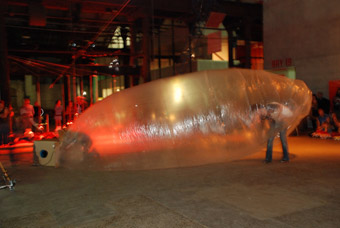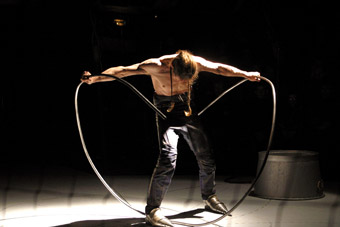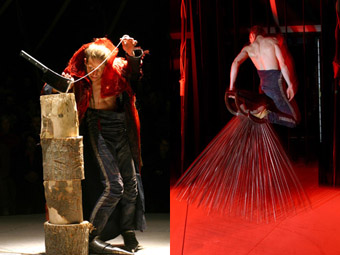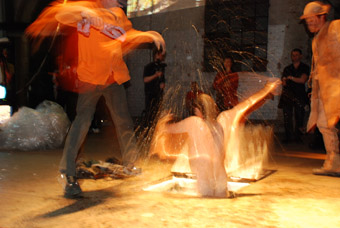construction as performance
keith gallasch admires the alchemies of cirque ici and volta

Clare Britton, Volta, Performance Space
photo Garth Knight
Clare Britton, Volta, Performance Space
LUCY GUERIN’S STRUCTURE AND SADNESS, JOEY RUIGROK VAN DER WERWEN’S VOLTA, CIRQUE ICI’S SECRET AND THE LATE TANJA LIEDTKE’S CONSTRUCT ARE JUST SOME OF A GROWING NUMBER OF WORKS IN A DIGITAL AGE THAT SHARE A PALPABLE AND POETIC ENGAGEMENT WITH THE MATERIAL WORLD: REAL PERFORMERS WORKING MAGIC ON REAL THINGS.
Of course, van der Werven (originally with Doegtroep in the Netherlands and then with Stalker, Marrugeku, Urban Theatre Projects and others in Australia) and France’s Cirque Ici have been at their distinctive alchemical labours for many years. Others have come to it later, including the artists who trained with van der Werven in UTP’s Mechanix in 2003 and in the first stage of Volta at Performance Space in September 2007.

Johann LeGuillerm, Cirque Ici, Secret, Sydney Festival
photo P Cibille
Johann LeGuillerm, Cirque Ici, Secret, Sydney Festival
Cirque Ici’s charismatic ringmaster and solo performer is Johann Le Guillerm, a lean, growling, caped figure wearing ridiculously long clattering foot armour. He works a long, thin metal rod into a near circle, creating a dynamic sprung hoop that he can roll away, casually predicting its imminent self-propelled return. The creations, whether this rod or a carpet that unfolds itself slowly, or a bird-like paper areoplane, or a roll of leather that mutates into a little pyramid, or the variously sized tin tubs that Le Guillerm spins into a galloping circle, are material objects made circus animals. He not only tames, trains and directs his charges, he places his body inside the arc of the metal hoop, rolling with it, puts his head into the pyramid (and is sucked into its tiny space, as if devoured), himself becoming part of a magically activated material world. He too is animal like, never speaks, repeatedly bares his fangs and exhales exaggeratedly like a wary beast or the creature from Alien.
In fact there is something quite alien about this persona, not least evident in the footwear suggestive of a hybrid creature especially when Le Guillerm astonishes us by standing en pointe—how can he do so when his boots run to such a fine point and are articulated in metal sections all the way to the heel? This man is another beast in his own show, with his own unique characteristics, not least a sense of time that cannot be hurried (to the consternation of those in the audience who prefer their circus fast and conventionally entertaining).

Johann LeGuillerm, Cirque Ici, Secret, Sydney Festival
photo P Cibille
Johann LeGuillerm, Cirque Ici, Secret, Sydney Festival
Some of Cirque Ici’s pre-constructed creations are sculptural, like the surreal ‘horse’ that comprises a saddle aloft myriad thin wire legs and which Le Guillerm rides elegantly about the ring, rocking to its easy, vibrating gait. In another act, he harnesses stage smoke into an eerie in-house tornado.
In the final act of Secret, Le Guillerm tames long, timber planks by roping them into a massive construction which he straddles as he works, constantly testing its strength and balance addition by addition until complete. He then swings cheekily ape-like from this creaking, trussed architectural monster which fills the stage, and makes his final exit. Secret is a marvellous circus-and-sculpture hybrid, yielding not only richly suggestive imagery but also beautifully crafted stand-alone creations inspired by natural forms from Le Guillerm and his collaborators.
At the end of Tanjia Liedtke’s Construct (RT81, p12), Kristina Chan is locked in a similar structure which has been steadily built about her in a show that commences wittily with the simplest of shape-forming, using hands and bodies, pieces of timber, a ladder, and moves towards a dark vision of relationship constraints. In Lucy Guerin’s Structure & Sadness (RT77, p39) the dancers also build, again starting small (and reflecting the processes of testing and balancing in duets) eventually creating a monstrous but fragile structure which falls, and a world has to be rebuilt. In both works the dancers are required to do much more than work their bodies—they build, they sculpt dexterously, juggling and manipulating strips of timber and moving on to shapes bigger than themselves.

Joey Ruigrok van der Werven, Volta, Performance Space
photo Garth Knight
Joey Ruigrok van der Werven, Volta, Performance Space
Joey Ruigrok van der Werven’s skill is in creating performative machines from materials at hand and of nurturing this talent in others. Volta, in the vast foyer of CarriageWorks, comprised devices made by the artists who drove them. Clare Britton unpacks and inflates a huge transparent plastic bubble, enters it, cuts her way out of its top and releases a toy chicken. Nick Wishart manipulates the semi-transparent torso of a shop dummy to yield shifting colours and sounds. Heidrun Löhr’s installation features suspended kettles over gas flames on a bed of coals; as the kettles whistle she raises and lowers them via pullies creating a score as if from a sibilant organ. There’s fire and light coming from above as Carlos Gomes, looking like someone from a folk Ring Cycle, fans a furious furnace, branding lateral directions onto timber signposts. Marley Dawson drops the head of a log high crane arm onto large metal balls, appearing to flatten them, and then rides the arm to the ground. Ouch! Van der Werven adds water to the fire and light, emerging naked in a wave of water from a hole in the floor and leaping into a go-cart about to be released from the huge taut band holding it back. Away he goes. Rod Nash’s low, rumbling, tooting vehicle enters, driverless, clearing a path for itself. Overhead, a single fluorescent light flies the length of the space like a rocket. Richard Manner’s sculpted clusters of small lights dance about in the dark like fireflies. Clare Britton re-enters the space carrying a small nest of light bulbs and magically lilluminates them with a mother bulb; one flies aloft and triggers a vast ceiling of tiny stars.
On the first of the two nights of Volta, the Federal Election became part of the show, thanks to Sean Bacon’s live media manipulations, and, on the second, the Australian Idol final. Volta blended performance with exhibition and a sense of occasion, allowing its audience to wander about, taking in the details of various creations and meeting the makers, while being treated to a steady stream of events. While a less seamless version might allow for more reflection, Volta has proved itself as a meeting ground for artists of all kinds and their audiences to share in an expanded sense of performance. More, please.
I should add to this short list of recent performances-as-construction Artspace’s Aftermath with its focus on performative installations over several months, where you could watch the artist at work, see the finished creation as performance and then observe subsequent transformations of the residue [RT81, p53]. Just as it’s been a pleasure to see the screen integrated so dynamically and inventively over the last decade into dance and contemporary performance, if still rarely in theatre, the engagement now with the materiality of things and across artforms is exhilarating. Of course, someone’s bound to object that it’s all been done before, and of course it has a history, but this is something more than re-inventing the wheel—these days there’s so much more you can do with a wheel [see Jean Poole on bicycles in the Istanbul Biennale, p28, and Gabriella Giannachi on Blast Theory’s Rider Spoke, p26].
Cirque Ici, Secret, creation, direction, interpretation Johann LeGuillerm, music Matthieu Werchowski, Guy Ajaguin, lighting Herve Gary; Sydney Festival 2007, Hyde Park, Sydney, Jan 14-26; Tanja Liedtke, Construct, Playhouse, Sydney Opera House, Jan 10-13; Volta, concept & direction Joey Ruigrok van der Werven, dramaturgy Clare Grant, artists Sean Bacon, Clare Britton, Marley Dawson, Carlos Gomes, Heidrun Löhr, Richard Manner, Rod Nash, Koen van Oosterhout, Simone O’Brien and Nick Wishart, Performance Space at CarriageWorks, 24, 25
RealTime issue #83 Feb-March 2008 pg. 40






